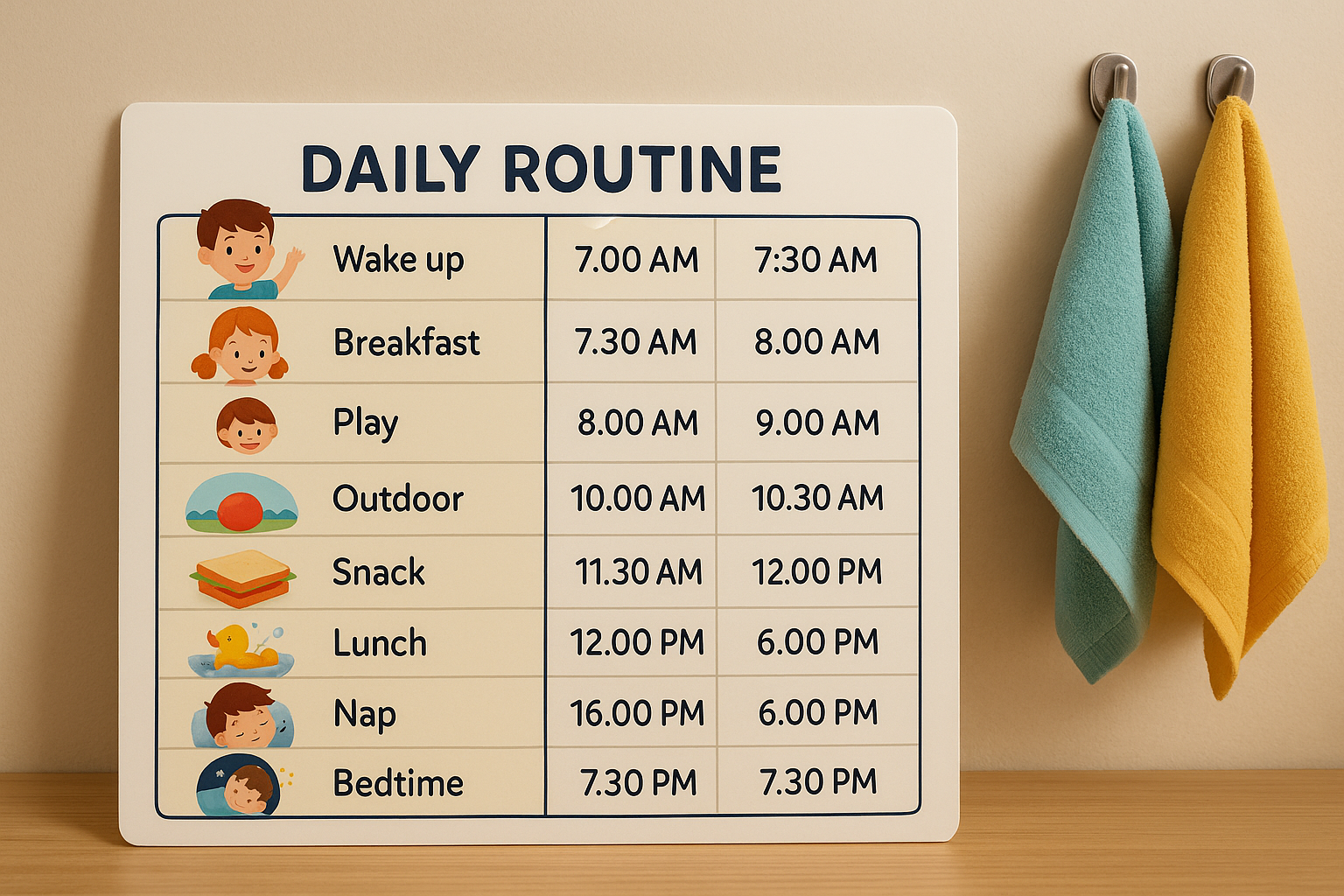Raising children comes with endless surprises, but one of the most powerful tools a parent or caregiver can use to create stability, comfort, and growth is routine. Establishing consistent patterns in a child’s day isn’t about being rigid or strict; it’s about creating a sense of safety and predictability that allows children to thrive.
In this article, we’ll explore why routine matters in early childhood and how you can implement simple, effective daily structures that benefit both children and parents.
Why Routine Matters for Children
Provides a Sense of Security
Children, especially toddlers and preschoolers, often feel overwhelmed by the unpredictability of the world. Having a routine helps them understand what comes next, reducing anxiety and helping them feel secure.
- Predictability brings comfort.
- Children learn that certain things happen regularly, like meals, naps, or bedtime.
- This sense of stability builds confidence.
Supports Emotional Regulation
When children know what to expect, they are less likely to experience stress-induced meltdowns. Routine:
- Reduces frustration caused by sudden transitions.
- Encourages emotional stability by providing structure.
- Helps toddlers feel more in control, even when their emotions are big.
Encourages Independence
When children follow a consistent routine, they naturally start taking responsibility for small tasks.
- Brushing teeth after breakfast becomes automatic.
- Tidying toys before dinner becomes part of the day.
- Kids learn responsibility without it feeling like a chore.
Supports Healthy Sleep Patterns
Sleep is one of the most important factors for a child’s physical and mental growth. A consistent bedtime routine:
- Signals to the body that it’s time to wind down.
- Improves sleep quality and reduces resistance to going to bed.
- Helps regulate mood and behavior during the day.
Fosters Learning and Development
Routines offer natural opportunities for learning. Whether it’s practicing washing hands, choosing clothes, or helping with small chores, children develop life skills through daily repetition.
- Repetition reinforces learning.
- Daily reading time supports language growth.
- Consistent playtime fosters creativity and problem-solving.
What a Simple Routine Looks Like
A good routine doesn’t need to be rigid. Flexibility is important, especially with young children. Here’s an example of a balanced daily routine for a toddler:
| Time | Activity |
|---|---|
| 7:00 AM | Wake up and cuddle time |
| 7:30 AM | Breakfast |
| 8:00 AM | Free play |
| 9:00 AM | Outdoor activity or walk |
| 10:00 AM | Snack |
| 10:30 AM | Learning time (books, puzzles) |
| 11:30 AM | Lunch |
| 12:00 PM | Nap |
| 2:00 PM | Snack |
| 2:30 PM | Creative play (arts, music) |
| 4:00 PM | Outdoor time or park |
| 5:00 PM | Quiet play |
| 6:00 PM | Dinner |
| 7:00 PM | Bath time |
| 7:30 PM | Storytime and bedtime routine |
| 8:00 PM | Bedtime |
Key Components of an Effective Routine
Consistent Wake-Up and Bedtime
Having a regular sleep schedule is foundational.
- Aim for the same wake-up and sleep times every day.
- Bedtime rituals (bath, story, lullaby) signal the brain to prepare for sleep.
Meal and Snack Times
Children thrive when they know when to expect food.
- Serve meals around the same time daily.
- Consistent snacks help maintain energy levels and moods.
Balanced Play and Rest
Include a mix of:
- Active play (running, park time)
- Creative play (drawing, singing)
- Quiet time (puzzles, books, cuddling)
Flexibility for Transitions
Life doesn’t always go as planned. Allow:
- Buffer times between activities.
- Flexibility for unexpected events or mood changes.
Tips for Introducing Routine
Start Small
- Focus on key transitions like bedtime, meals, and naps first.
- Once these feel natural, add more structure around play or learning.
Use Visual Schedules
For toddlers and preschoolers, visual cues help:
- Create a chart with pictures of daily activities.
- Let the child move a marker or sticker to each activity as it happens.
Model the Routine
Children learn best by watching. Stick to the routine yourself:
- Narrate your actions: “After we eat, it’s time to clean up together.”
- Celebrate when routines go smoothly.
Be Patient
Adjusting to routine takes time.
- Expect resistance, especially with new habits.
- Offer gentle reminders and lots of praise.
Common Challenges and How to Handle Them
What If My Child Resists?
- Stay consistent but calm.
- Offer choices within the routine: “Do you want to brush your teeth before or after putting on pajamas?”
What If Life Interrupts the Routine?
- Vacations, illness, or visitors can disrupt routines.
- Focus on maintaining key parts (meals, sleep) and return to full routine when possible.
What If I Feel Overwhelmed?
- Routines should help, not stress you.
- If it feels like too much, simplify—prioritize bedtime, meals, and one or two key daily moments.
Final Thoughts: Routine as a Form of Love
Routine is more than just structure — it’s a daily message to your child that the world is safe, predictable, and full of care. Through simple, consistent rhythms, you help them grow emotionally, physically, and mentally.
As your child grows, routines will evolve. But the sense of security and love they create will remain a foundation for years to come.
